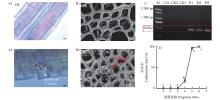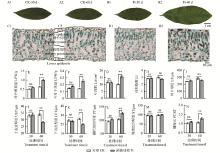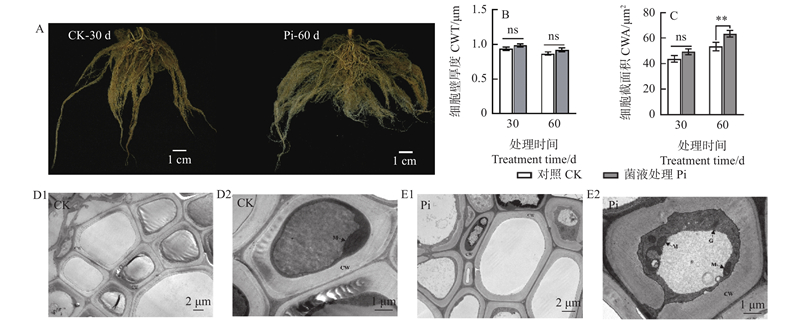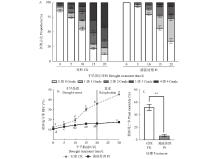

Scientia Silvae Sinicae ›› 2024, Vol. 60 ›› Issue (1): 93-102.doi: 10.11707/j.1001-7488.LYKX20230202
Previous Articles Next Articles
Yue Fan,Peirun Luo,Wei Wang,Qian Xie,Qingxi Chen*( )
)
Received:2023-05-14
Online:2024-01-25
Published:2024-01-29
Contact:
Qingxi Chen
E-mail:.cqx0246@163.com
CLC Number:
Yue Fan,Peirun Luo,Wei Wang,Qian Xie,Qingxi Chen. Establishment of Symbiotic System of Piriformospora indica and Rhododendron and Its Effect on Improving Drought Resistance[J]. Scientia Silvae Sinicae, 2024, 60(1): 93-102.
Table 1
Leaf morphological grade standard of Rhododendron under drought stress"
| 等级 Grade | 叶片生长情况 Leaf growth |
| 0 | 生长状态良好,无萎蔫现象出现 The growth state is good, no wilting phenomenon appears. |
| 1 | 幼叶反卷,10%以下叶片出现萎蔫、下垂、皱缩现象 The young leaves rolled back, leaves below 10% appear wilting, drooping and shrinking. |
| 2 | 幼叶反卷,10%~29%以下叶片出现萎蔫、下垂、皱缩现象 The young leaves rolled back, leaves below 10%-29% appear wilting, drooping and shrinking. |
| 3 | 幼叶反卷,30%~59%以下叶片出现萎蔫、下垂、皱缩现象 The young leaves rolled back, leaves below 30%-59% appear wilting, drooping and shrinking. |
| 4 | 幼叶反卷,60%以上叶片出现萎蔫、下垂、皱缩现象 The young leaves rolled back, more than 60% leaves appear wilting, drooping and shrinking. |

Fig.1
The colonization of P. indica A1 is the uncolonized root after Trypan blue staining; A2 is the colonized root after Trypan blue staining; B1 is the uncolonized root under scanning electron microscope; B2 is the colonized root under scanning electron microscope; C shows the molecular detection results of Pi group; D shows the colonization rate of P. indica; The different lowercase letters indicate a significant difference at 0.05 level. CK:对照control;Pi:印度梨形孢菌液处理P. indica liquid treatment."


Fig.2
Changes of leaf morphological structure after P. indica colonization A1 and A2 refer to the leaves treated with CK for 30 and 60 days, respectively; B1 and B2 refer to the leaves treated with P. indica liquid for 30 and 60 days; C1 and C2 refer to the cross-sectional anatomical structure of leaves treated with CK for 30 and 60 days; D1 and D2 refer to the cross-sectional anatomical structure of leaves treated with P. indica liquid for 30 and 60 days; E–N represents the LFW (leaf fresh weight), LDW (leaf dry weight), LA (leaf area), LI (leaf index), LT (leaf thickness), UET (upper epidermis thickness), LET (lower epidermis thickness), PT (palisade parenchyma thickness), ST (spongy parenchyma thickness), and P/S (palisade to spongy ratio of leaves treated with CK and P. indica liquid for 30 and 60 days, respectively."


Fig.3
Effect of colonization P. indica on root ultrastructure A is the root system of CK group ( left ) and Pi group ( right ) after 60 days of treatment; B is the thickness of the cell wall; C is the cross-sectional area of the cell; D1 and D2 are root cells of the CK group treated for 60 days, with magnifications of 2 500 and 7 000 times, respectively; E1 and E2 are root cells of the Pi group treated for 60 days, with magnifications of 2 500 and 7 000 times, respectively. CW: 细胞壁Cell wall; M: 线粒体Mitochondria; G: 高尔基体Golgi."


Fig.4
Effects of colonizing P. indica on plant drought resistance A: The grading of wilting damage of leaves in CK and Pi groups under different stress time was studied; B: The relative conductivity of CK and Pi group leaves under different stress time; C: The death rate of plants after 10 days of rewatering."

| 陈树钢, 丁彦芬. 以电导法配合Logistic方程确定5种景天属植物耐旱性. 江苏农业科学, 2011, 39 (3): 213- 216. | |
| Chen S G, Ding Y F. Determination of drought tolerance of 5 species of Sedum by conductance method and Logistic equation. Jiangsu Agricultural Sciences, 2011, 39 (3): 213- 216. | |
| 高晓宁, 赵 冰, 刘旭梅, 等. 4个杜鹃花品种对干旱胁迫的生理响应及抗旱性评价. 浙江农林大学学报, 2017, 34 (4): 597- 607. | |
| Gao X N, Zhao B, Liu X M, et al. Physiological response to drought stress and drought resistance evaluation of four Rhododendron cultivars. Journal of Zhejiang A & F University, 2017, 34 (4): 597- 607. | |
| 李 婧, 汤升虎, 童 琪, 等. 杜鹃属植物及在园林景观中的应用. 现代园艺, 2020, 43 (15): 66- 68. | |
| Li J, Tang S H, Tong Q, et al. Rhododendron and its application in garden landscape. Modern Gardening, 2020, 43 (15): 66- 68. | |
| 林振显. 福鼎市城区主要道路绿化树种调查及分析. 乡村科技, 2021, 12 (17): 94- 97. | |
| Lin Z X. Investigation and analysis of greening tree species on main roads in Fuding city. Rural Technology, 2021, 12 (17): 94- 97. | |
| 刘晓曦. 2015. 印度梨形孢培养条件优化和剂型研制及在油菜上的应用研究. 杭州: 浙江大学. | |
| Liu X X. 2015. Optimization of culture conditions and formulation development of Piriformospora indica and its application in rapeseed. Hangzhou: Zhejiang University. [in Chinese] | |
| 刘 影, 赵禹宁. 2015. 杜鹃花属植物在北方园林中的应用. 中国林副特产, (2): 74-75. | |
| Liu Y, Zhao Y N. 2015. Utilization of Rhododendron L. in garden in northern area of China. Forest by-Product and Speciality in China, (2): 74-75. [in Chinese] | |
| 蒲 尧. 2021. 印度梨形孢对小白菜生物量、品质以及硒累积的影响. 荆州: 长江大学. | |
| Pu Y. 2021. Effects of Piriformospora indica on biomass, quality and selenium accumulation of Chinese cabbage. Jingzhou: Changjiang University. [in Chinese] | |
| 沈荫椿. 2016. 杜鹃花. 北京: 中国林业出版社. | |
| Shen Y C. 2016. Azaleas. Beijing: China Forestry Publishing House. [in Chinese] | |
| 史清英. 2015. 三叶青茎段外植体组织培养体系的优化及印度梨形孢对其生长的影响. 杭州: 浙江大学. | |
| Shi Q Y. 2015. Optimization of tissue culture system for stem explants of Tetrastigma hemsleyanum and effect of Piriformospora indica on its growth. Hangzhou: Zhejiang University. [in Chinese] | |
| 宋明波, 穆立蔷. 杜鹃属植物资源及园林应用. 特种经济动植物, 2022, 25 (2): 103- 104. | |
| Song M B, Mu L Q. Resources of Rhododendron and its landscape application. Special Economic Animal and Plant, 2022, 25 (2): 103- 104. | |
| 孙 超. 2010. 印度梨形孢诱导小白菜抗病、促生、抗逆的作用及其机理的初步研究. 杭州: 浙江大学. | |
| Sun C. 2010. Preliminary study on the role and mechanism of Piriformospora indica in inducing disease resistance, growth promotion and stress resistance of Chinese cabbage. Hangzhou: Zhejiang University. [in Chinese] | |
| 汤章城. 逆境条件下植物脯氨酸的累积及其可能的意义. 植物生理学通讯, 1984, (1): 15- 21. | |
| Tang Z C. Accumulation of proline in plants under stress and its possible significance. Plant Physiology Communications, 1984, (1): 15- 21. | |
| 唐明作. 2021. 菌根真菌提高杨树耐旱耐盐性. 咸阳: 西北农林科技大学出版社. | |
| Tang M Z. 2021. Mycorrhizal fungi improve drought and salt tolerance of poplar. Xianyang: Northwest A & F University Press. [in Chinese] | |
| 王宝山. 2010. 逆境植物生物学. 北京: 高等教育出版社. | |
| Wang B S. 2010. Plant biology under stress. Beijing: Higher Education Press. [in Chinese] | |
| 王慧俐. 2015. 印度梨形孢Piriformospora indica对果蔬生长、品质及抗病性的影响及其相关机制研究. 杭州: 浙江大学. | |
| Wang H L. 2015. Effects of Piriformospora indica on the growth, quality and disease resistance of fruits and vegetables and its related mechanisms. Hangzhou: Zhejiang University. [in Chinese] | |
| 王建华, 刘鸿先, 徐 同. 超氧物歧化酶(SOD)在植物逆境和衰老生理中的作用. 植物生理学通讯, 1989, (1): 1- 7. | |
| Wang J H, Liu H X, Xu T. The role of superoxide dismutase (SOD) in stress physiology and senescence physiology of plant. Plant Physiology Communications, 1989, (1): 1- 7. | |
| 王学奎, 黄见良. 2015. 植物生理生化实验原理与技术. 北京: 高等教育出版社, 306. | |
| Wang X K, Huang J L. 2015. Principles and techniques of plant physiological biochemical experiment. Beijing: Higher Education Press. [in Chinese] | |
| 韦 巧. 2017. 印度梨形孢溶磷特性及促进甘蓝型油菜磷吸收的研究. 荆州: 长江大学. | |
| Wei Q. 2017. Character of phosphate soublizing of Piriformospora indica and effects on phosphours absorption in Brassica naups. Jingzhou: Changjiang University. [in Chinese] | |
| 魏志刚, 王玉成. 2015. 植物干旱胁迫响应机制. 北京: 科学出版社. | |
| Wei Z G, Wang Y C. 2015. Response mechanism of plant to drought stress. Beijing: Science Press. [in Chinese] | |
| 徐 忠, 张春英. 2014. 上海杜鹃花栽培及应用. 北京: 中国林业出版社. | |
| Xu Z, Zhang C Y. 2014. Cultivation and application of Rhododendron in Shanghai. Beijing: China Forestry Publishing House. [in Chinese] | |
| 叶 菁, 晏琴梅, 魏 晖, 等. 杜鹃不同品种在园林中配置及应用方式. 绿色科技, 2020, (23): 46- 48. | |
| Ye J, Yan Q M, Wei H, et al. Configuration and application of different varieties of Rhododendron in gardens. Green Technology, 2020, (23): 46- 48. | |
| 张长芹. 2003. 杜鹃花. 北京: 中国建筑工业出版社. | |
| Zhang C Q. 2003. Azalea. Beijing: China Architecture & Building Press. [in Chinese] | |
| 郑 颖. 2018. 6个新引进杜鹃品种的抗旱性评价. 福州: 福建农林大学. | |
| Zheng Y. 2018. Drought resistance evaluation of 6 newly introduced Rhododendron varieties. Fuzhou: Fujian Agriculture and Forestry University. [in Chinese] | |
|
Bidartondo M I, Redecker D, Hijri I, et al. Epiparasitic plants specialized on arbuscular mycorrhizal fungi. Nature, 2002, 419 (6905): 389- 392.
doi: 10.1038/nature01054 |
|
| Blum A. 2011. Drought resistance—is it really a complex trait? Functional Plant Biology, 38(10): 753-757. | |
|
Bonfante P, Anca I. Plants, mycorrhizal fungi, and bacteria: a network of interactions. Annual Review of Microbiology, 2009, 63, 363- 383.
doi: 10.1146/annurev.micro.091208.073504 |
|
| Cao J L, He W X, Zou Y N, et al. An endophytic fungus, Piriformospora indica, enhances drought tolerance of trifoliate orange by modulating the antioxidant defense system and composition of fatty acids. Tree Physiology, 2023, 43 (3): 452- 466. | |
|
Diagne N, Ngom M, Djighaly P I, et al. Roles of arbuscular mycorrhizal fungi on plant growth and performance: importance in biotic and abiotic stressed regulation. Diversity, 2020, 12 (10): 370.
doi: 10.3390/d12100370 |
|
|
Fang Y J, Xiong L Z. General mechanisms of drought response and their application in drought resistance improvement in plants. Cellular and Molecular Life Sciences, 2015, 72 (4): 673- 689.
doi: 10.1007/s00018-014-1767-0 |
|
|
Fathi A, Tari D B. Effect of drought stress and its mechanism in plants. International Journal of Life Sciences, 2016, 10 (1): 1- 6.
doi: 10.3126/ijls.v10i1.14509 |
|
| Ghabooli M, Rezaei E, Movahedi Z, et al. Effect of Piriformospora indica inoculation on some morphophysiological parameters in licorice (Glycyrrhiza glabra L.) under drought stress. Iranian Journal of Plant Physiology, 2020, 10 (4): 3379- 3389. | |
|
Ghaffari M R, Mirzaei M, Ghabooli M, et al. Root endophytic fungus Piriformospora indica improves drought stress adaptation in barley by metabolic and proteomic reprogramming. Environmental and Experimental Botany, 2019, 157, 197- 210.
doi: 10.1016/j.envexpbot.2018.10.002 |
|
|
Guo Z H, Liu X Q, Su J L, et al. Species diversity of Rhododendron shrub communities and utilization of Rhododendron resources in urban green spaces of Nanjing. Tropical Ecology, 2022, 63 (4): 506- 521.
doi: 10.1007/s42965-022-00219-z |
|
|
Hosseini F, Mosaddeghi M R, Dexter A R. Effect of the fungus Piriformospora indica on physiological characteristics and root morphology of wheat under combined drought and mechanical stresses. Plant Physiology and Biochemistry, 2017, 118, 107- 120.
doi: 10.1016/j.plaphy.2017.06.005 |
|
|
Hosseini F, Mosaddeghi M R, Dexter A R, et al. Maize water status and physiological traits as affected by root endophytic fungus Piriformospora indica under combined drought and mechanical stresses. Planta, 2018, 247 (5): 1229- 1245.
doi: 10.1007/s00425-018-2861-6 |
|
| Hussain S, Rao M J, Anjum M A, et al. 2019. Oxidative stress and antioxidant defense in plants under drought conditions//Hasanuzzaman M, Hakeem K R, Nahar K. eds. Plant abiotic stress tolerance: agronomic, molecular and biotechnological approaches. Berlin: Springer, 207−219. | |
|
Hussin S, Khalifa W, Geissler N, et al. Influence of the root endophyte Piriformospora indica on the plant water relations, gas exchange and growth of Chenopodium quinoa at limited water availability. Journal of Agronomy and Crop Science, 2017, 203 (5): 373- 384.
doi: 10.1111/jac.12199 |
|
|
Kaya C, Ashraf M, Wijaya L, et al. The putative role of endogenous nitric oxide in brassinosteroid-induced antioxidant defence system in pepper (Capsicum annuum L.) plants under water stress. Plant Physiology and Biochemistry, 2019, 143, 119- 128.
doi: 10.1016/j.plaphy.2019.08.024 |
|
| Lynn J, Peeva N. Communications in the IPCC’s sixth assessment report cycle. Climatic Change, 2021, 169 (1/2): 18. | |
|
Mahajan S, Tuteja N. Cold, salinity and drought stresses: an overview. Archives of Biochemistry and Biophysics, 2005, 444 (2): 139- 158.
doi: 10.1016/j.abb.2005.10.018 |
|
|
Oelmüller R, Sherameti I, Tripathi S, et al. Piriformospora indica, a cultivable root endophyte with multiple biotechnological applications. Symbiosis, 2009, 49 (1): 1- 17.
doi: 10.1007/s13199-009-0009-y |
|
|
Patel J A, Vora A B. Free proline accumulation in drought-stressed plants. Plant and Soil, 1985, 84 (3): 427- 429.
doi: 10.1007/BF02275480 |
|
|
Pooja J, Kanwar S P, Alka B, et al. Role of Serendipita indica in enhancing drought tolerance in crops. Physiological and Molecular Plant Pathology, 2021, 116, 101691.
doi: 10.1016/j.pmpp.2021.101691 |
|
|
Sahay N S, Varma A. Piriformospora indica: a new biological hardening tool for micropropagated plants. FEMS Microbiology Letters, 1999, 181 (2): 297- 302.
doi: 10.1111/j.1574-6968.1999.tb08858.x |
|
|
Scandalios J G. Oxygen stress and superoxide dismutases. Plant Physiology, 1993, 101 (1): 7- 12.
doi: 10.1104/pp.101.1.7 |
|
|
Sun C, Johnson J M, Cai D G, et al. Piriformospora indica confers drought tolerance in Chinese cabbage leaves by stimulating antioxidant enzymes, the expression of drought-related genes and the plastid-localized CAS protein. Journal of Plant Physiology, 2010, 167 (12): 1009- 1017.
doi: 10.1016/j.jplph.2010.02.013 |
|
| Tsai H J, Shao K H, Chan M T, et al. Piriformospora indica symbiosis improves water stress tolerance of rice through regulating stomata behavior and ROS scavenging systems. Plant Signaling & Behavior, 2020, 15 (2): 1722447. | |
| Varma A, Khanuja M. 2017. Role of nanoparticles on plant growth with special emphasis on Piriformospora indica: a review//Ghorbanpour M, Khanuja M, Varma A. eds. Nanoscience and plant-soil systems. Berlin: Springer, 387−403. | |
| Verma S, Varma A, Rexer K, et al. Piriformospora indica, gen. et sp. nov. , a new root-colonizing fungus. Mycologia, 1998, 90 (5): 896- 903. | |
| Vogelmann T C, Martin G. 1993. The functional significance of palisade tissue: penetration of directional versus diffuse light. Plant, Cell & Environment, 16(1): 65−72. | |
|
Zhang H, Sun X P, Dai M Q. Improving crop drought resistance with plant growth regulators and rhizobacteria: mechanisms, applications, and perspectives. Plant Communications, 2022, 3 (1): 100228.
doi: 10.1016/j.xplc.2021.100228 |
|
| Zhang W Y, Wang J, Xu L, et al. Drought stress responses in maize are diminished by Piriformospora indica. Plant Signaling & Behavior, 2018, 13 (1): e1414121. |
| [1] | Tayan Xu,Wenxuan Quan,Chaochan Li,Yannan Pan,Lijuan Xie,Jiangtao Hao,Yongdao Gao. Distribution Characteristics of Low Molecular Weight Organic Acids in Soil of Wild Rhododendron Forest [J]. Scientia Silvae Sinicae, 2021, 57(8): 24-32. |
| [2] | Chengling Huang,Gang Yao,Xiaoling Tian,Yongquan Ren,Jiayong Huang,Yongpeng Ma. Phylogenomic Analysis of Rhododendron Species in Guizhou Baili Rhododendron Reserve Based on RAD Sequencing [J]. Scientia Silvae Sinicae, 2021, 57(2): 72-81. |
| [3] | Wei Jin,Yuzhan Yang,Haijing Sun,Lianqing Chen,Zhilin Yuan. Diversity of Ectomycorrhizal Fungi a Seed Collecting Forest of Quercus virginiana [J]. Scientia Silvae Sinicae, 2020, 56(1): 120-132. |
| [4] | Lu Huijun, Li Ziyi, Liang Hanyu, Yue Yuanzhi, Zhou Tianchang, Yang Yuzhang, Wang Yucheng, Ji Xiaoyu. Expression and Stress Tolerance Analysis of NAC24 from Tamarix hispida [J]. Scientia Silvae Sinicae, 2019, 55(3): 54-63. |
| [5] | Zhang Jiangtao, Yang Shuhong, Zhu Di, Zhu Yanlin, Liu Youquan. Physiological Response of Annual Grafted Seedlings of Poplar 2025 and Its Two Bud Mutation Varieties to Drought Stress and Evaluation of Drought Resistance [J]. Scientia Silvae Sinicae, 2018, 54(6): 33-43. |
| [6] | Chen Wenrong, Pan Xia, Shao Junyi, Liao Fanglei, Yang Li, Hu Yingying, Yu Ying, Guo Weidong. Cloning,Expression and Analysis of Drought Resistance of VcLon1 Gene from Blueberry [J]. Scientia Silvae Sinicae, 2018, 54(6): 73-84. |
| [7] | Tang Feifei, Zhao Yulin, Wang Peilong, Feng Deming, Song Yi, Gao Caiqiu. Cloning and Stress Tolerance Analysis of ThP5CR from Tamarix hispida [J]. Scientia Silvae Sinicae, 2017, 53(7): 1-9. |
| [8] | Du Mingfeng, Ding Guijie, Zhao Xizhou. Responses to Continuous Drought Stress and Drought Resistance of Different Masson Pine Families [J]. Scientia Silvae Sinicae, 2017, 53(6): 21-29. |
| [9] | Luo Qinghong, Ning Husen, He Miao, Ji Xiaomin, Lei Chunying. Ecophysiological Responses of Five Sandy Shrubs to Drought Stress [J]. Scientia Silvae Sinicae, 2017, 53(11): 29-42. |
| [10] | Pang Li, Zhou Zhichun, Zhang Yi, Feng Zhongping. Effects of Simulated Continuous N Sedimentation on the Ectomycorrhizal Symbiosis and soil Nutrients of 2-Year-Old Pinus massoniana Seedlings Under Low P Stress [J]. Scientia Silvae Sinicae, 2016, 52(8): 138-145. |
| [11] | Gao Runmei, Shi Xiaodong, Wang Lin, Han Na. Drought Resistance of One-Year-Old Seedlings of Larix principis-rupprechtii [J]. Scientia Silvae Sinicae, 2015, 51(7): 148-156. |
| [12] | Li Chaochan, Yi Yin, Quan Wenxuan, Tian Honghong. The Natural Volatile Components of Allelochemicals in the Wild Alpine Rhododendron Community [J]. Scientia Silvae Sinicae, 2015, 51(12): 35-44. |
| [13] | Ye Songtao, Du Xuhua, Song Shuaijie, Li Li, Lu Yang, Ying Yeqing. Effect of Salicylic Acid on Physiological and Biochemical Characteristics of Phyllostachys edulis Seedlings under Drought Stress [J]. Scientia Silvae Sinicae, 2015, 51(11): 25-31. |
| [14] | Xing Cunwang, Huang Xuanrui, Li Yuling, Ma Zengwang, Fu Xiaoyan. Ecological Stability of Sand-Fixed Plantations in Huangyangtan [J]. Scientia Silvae Sinicae, 2014, 50(5): 101-108. |
| [15] | Zhang Weixi, Liu Boyang, Ding Changjun, Zhang Bingyu, Huang Qinjun, Chu Yanguang, Su Xiaohua. Transformation of Zinc Finger Protein Transcription Factor Gene (ZxZF) and Preliminary Evaluation of Drought Tolerance in Populus × euramericana [J]. Scientia Silvae Sinicae, 2014, 50(3): 31-37. |
| Viewed | ||||||
|
Full text |
|
|||||
|
Abstract |
|
|||||